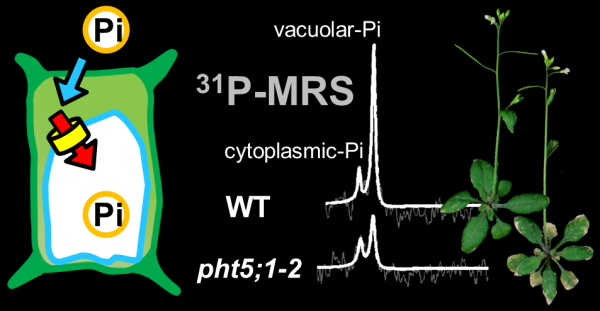Research Focus
Regulatory network in sensing phosphate availability in plants
Phosphorus (P) is one of the essential mineral nutrients required for plant growth and development, but its availability in the form of phosphate (Pi) in the soil is limited. To overcome this limited supply, plants have developed multiple strategies to increase the uptake of external Pi as well as conserve and remobilize internal Pi, that are regulated by a complex network.
MicroRNAs (miRNAs), a class of endogenous non-coding small RNAs, have emerged as new regulators in Pi-starvation responses. In Arabidopsis, miR399 and miR827, induced by Pi deficiency, post-transcriptionally downregulate PHOSPHATE2 (PHO2) that encodes a ubiquitin-conjugating E2 enzyme and NITROGEN LIMITATION ADAPTATION (NLA) that encodes a RING-type ubiquitin-ligating E3 enzyme, respectively. Recently, our studies applied genetic and proteomic approaches to elucidate the downstream components of PHO2 and NLA have highlighted that regulation of Pi transporters lies at the core of miRNA-mediated surveillance of Pi homeostasis. PHO2 regulates the root-to-shoot transport of Pi by interacting with the endomembrane-localized PHOSPHATE1 (PHO1) followed by its vacuolar degradation. In addition, PHO2 interacts with several PHOSPHATE TRANSPORTER1 (PHT1) proteins involved in Pi acquisition and mediates their protein stability. These findings suggest that PHO2 operates a bifurcated regulation on the two sequential yet functionally linked steps – Pi acquisition and xylem loading of the radial Pi transport across the root, which is essential for coordination of Pi allocation. Our studies further reveal that the involvement of miR399-PHO2 and miR827-NLA modules in two different ubiquitin conjugation cascades independently but cooperatively contributes to the post-translational regulation of PHT1s, which eventually determines the Pi uptake activity at the cell surface.
Recently, we identified the Arabidopsis SPX-MFS family (PHT5 Pi transporter family) as the long-sought-after vacuolar Pi importer by providing compelling results for their essential role in the vacuolar storage or sequestration of Pi as well as the maintenance of cytoplasmic Pi homeostasis. Furthermore, we provide direct evidence demonstrating that the expression of the majority of Pi starvation-responsive genes is regulated by “cytoplasmic” Pi concentrations. Our findings offer a new direction for the exploration of the molecular mechanisms underlying the regulation of vacuolar Pi transporters that plants utilize to coordinate vacuolar Pi transport activity with the cellular metabolisms and environmental fluctuations.
In addition to miRNAs, the potential roles of other signal molecules, such as inositol polyphosphates, in Pi signaling and systemic regulation of Pi homeostasis is being explored. Our research may offer knowledge for the improvement of P use efficiency of crops to achieve sustainable agricultural production in the future.



Kuo-Chen Yeh
Distinguished Research Fellow and Director
Director (2019.1.16-present)
Interim Director (2016.10.1 -2019.1.15)
Director/Coordinator of Molecular and Biological Agricultural Sciences program of Taiwan International Graduate Program (TIGP-MBAS), Academia Sinica (2015-2020)
Distinguished Research Fellow (2024-present)
Research Fellow (2014-2024)
Associate Research Fellow (2009-2013)
Assistant Research Fellow (2001-2009)
PDF Howard Hughes Medical Institute and Department of Biological Sciences, Stanford University, USA (1999-2001)
Ph.D. Plant Biology Graduate Group, University of California, Davis, USA (1994-1999)

